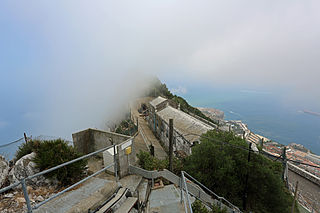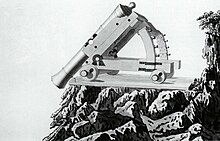
A railway gun, also called a railroad gun, is a large artillery piece, often surplus naval artillery, mounted on, transported by, and fired from a specially designed railway wagon. Many countries have built railway guns, but the best-known are the large Krupp-built pieces used by Germany in World War I and World War II. Smaller guns were often part of an armoured train. Only able to be moved where there were good tracks, which could be destroyed by artillery bombardment or airstrike, railway guns were phased out after World War II.

Gun laying is the process of aiming an artillery piece or turret, such as a gun, howitzer, or mortar, on land, in air, or at sea, against surface or aerial targets. It may be laying for direct fire, where the gun is aimed similarly to a rifle, or indirect fire, where firing data is calculated and applied to the sights. The term includes automated aiming using, for example, radar-derived target data and computer-controlled guns.

The Great Siege of Gibraltar was an unsuccessful attempt by Spain and France to capture Gibraltar from the British during the War of the American Revolution. It was the largest battle in the war by number of combatants.

The 6-inch siege gun model 1877 was a Russian 152.4 mm (6 in) fortress gun, siege gun and coastal defense gun. It was used in the Russo-Japanese War, World War I, and the Russian Civil War. The successor states of the Russian Empire also inherited a number of M1877 guns.

The Great Siege Tunnels in the British Overseas Territory of Gibraltar, also known as the Upper Galleries, are a series of tunnels inside the northern end of the Rock of Gibraltar. They were dug out from the solid limestone by the British during the Great Siege of Gibraltar of the late 18th century.

Princess Royal's Battery is an artillery battery in the British Overseas Territory of Gibraltar. It is located on Willis's Plateau at the northern end of the Upper Rock Nature Reserve, just southeast of Princess Anne's Battery. Formerly known as Willis' Battery, and later, Queen Anne's Battery or Queen's Battery, it was renamed in the late 18th century after Charlotte, Princess Royal, the eldest daughter of George III. The battery was active from the early 18th century until at least the mid-20th century. However, it has been decommissioned and guns are no longer present. Princess Royal's Battery is listed with the Gibraltar Heritage Trust.

The Soldier Artificer Company was a unit of the British Army raised in Gibraltar in 1772 to work on improving the fortifications there. It was the Army's first unit of military artificers and labourers – the existing Corps of Engineers was entirely made up of commissioned officers – and it replaced the traditional but unreliable practice of employing civilian craftsmen. The company was an immediate success and was responsible for upgrading the British fortress's defences before the Great Siege of Gibraltar.

Spy Glass Battery or Spyglass Battery was originally a high angle artillery battery in the British Overseas Territory of Gibraltar. The battery is mounted high on the rock to give extra range and protection. The battery was still in use during the Second World War as a listening post and site for a Bofors Gun.

George Frederick Koehler was a British artist, soldier and engineer. He is known for creating a gun that recoiled allowing it to fire down the side of a mountain without sending the gun carriage flying into the air. The Koehler Depressing Carriage is still commemorated today in Gibraltar where it was an important defence during the Great Siege of Gibraltar.
Willis' Battery is a former artillery battery on the north side of the British Overseas Territory of Gibraltar. It overlooks the isthmus between Spain and Gibraltar.

The Gibraltar peninsula, located at the far southern end of Iberia, has great strategic importance as a result of its position by the Strait of Gibraltar where the Mediterranean Sea meets the Atlantic Ocean. It has repeatedly been contested between European and North African powers and has endured fourteen sieges since it was first settled in the 11th century. The peninsula's occupants – Moors, Spanish, and British – have built successive layers of fortifications and defences including walls, bastions, casemates, gun batteries, magazines, tunnels and galleries. At their peak in 1865, the fortifications housed around 681 guns mounted in 110 batteries and positions, guarding all land and sea approaches to Gibraltar. The fortifications continued to be in military use until as late as the 1970s and by the time tunnelling ceased in the late 1960s, over 34 miles (55 km) of galleries had been dug in an area of only 2.6 square miles (6.7 km2).

The Prince's Lines are part of the fortifications of Gibraltar, situated on the lower slopes of the north-west face of the Rock of Gibraltar. They are located at a height of about 70 feet (21 m) on a natural ledge above the Queen's Lines, overlooking the landward entrance to Gibraltar, and run from a natural fault called the Orillon to a cliff at the southern end of the isthmus linking Gibraltar with Spain. The lines face out across the modern Laguna Estate, which stands on the site of the Inundation, an artificial lake created to obstruct landward access to Gibraltar. They were constructed to enfilade attackers approaching Gibraltar's Landport Front from the landward direction.

The 15 cm sFH 93 was a German howitzer which served in a number of colonial conflicts, the Balkan Wars and World War I.

The 8-inch mortar M1877 was a Russian 203 mm (8 in) coastal, fortress and siege mortar that was used in the Russo-Japanese War and World War I.

The 9-inch mortar M1877 was a Russian 229 mm (9 in) coastal, fortress and siege mortar that was used in the Russo-Japanese War and World War I.

The 21 cm Mörser 99 was a German siege mortar built by Krupp which served during World War I. The mortar utilized a new nickel-steel alloy of greater strength than other cast cannons, though it lacked a recoil mechanism. While the gun was more effective than previous models, it was soon phased out because of improved field artillery and counter-battery fire, though it remained in service in limited numbers throughout the war because of heavy German losses.

The 9 cm Kanone C/79 was a fortress and siege gun developed after the Franco-Prussian War and used by Germany before and during World War I.

The 12 cm Kanone C/80 was a fortress and siege gun developed after the Franco-Prussian War and used by Germany before and during World War I.

The 15 cm Ring Kanone C/72 was a fortress and siege gun developed after the Franco-Prussian War and used by Germany and Portugal before and during World War I.

The 15 cm Ring Kanone C/92 was a fortress and siege gun developed in the 1880s that saw service in the Italo-Turkish War, Balkan Wars, and World War I.























